Physical Address
304 North Cardinal St.
Dorchester Center, MA 02124
The critically ill patient, particularly the critically ill difficult airway patient, presents unique airway challenges in emergency situations outside the operating room. The risk of life-threatening complications, including anoxic brain injury, death, and long-term disability, are exaggerated in this patient group when undergoing urgent/emergent airway management in the remote location. Physical examination of the patient is helpful to identify difficult airway characteristics, yet many remain subtle or difficult to recognize in the urgent setting. Routine assessment in the elective operating room setting is more comprehensive when compared with the agitated, hypoxic, sedated, hemodynamically unstable intensive care unit (ICU) patient suffering deterioration leading to an airway intervention. Risk factors vary but include body mass index (BMI) >30, a history of difficult airway, past or current presence of head and neck tumor ± radiation therapy to the head/neck region, history of chronic obstructive pulmonary disease (COPD), current or past tracheostomy, cervical spine limitations, airway edema, mass effect, swelling (angioedema), and airway soilage (bleeding, emesis).
Critical care provided to the ICU patient is often multidisciplinary; hence, there are a variety of approaches and schema to manage the airway. Optimally, a standardized approach for airway management should be agreed upon within your institution that reflects the concerns for all specialties. Different specialties may prefer their own algorithms or guidelines for airway management, yet it is important that a standardized approach for airway management be agreed. Despite the presence of a multitude of guidelines and algorithms from regional, national, and international sources, the vast majority reflect very similar philosophies and schema to manage the known or suspected difficult airway patient. Adherence to the American Society of Anesthesiologists (ASA) guidelines is common, but not universal. Collaboration will enhance patient care and should improve safety and outcome. Combining the ASA difficult airway algorithm/guidelines with the Chimes’ Vortex approach may be beneficial to all. The Vortex approach advances one’s ability to visual the progression from bag-valve-mask (BVM) ventilation, placement of supraglottic airway (SGA) or endotracheal tube (ETT) via laryngoscopy, advising the team to use no more than three attempts (or fewer), which should prompt movement to a standardized surgical technique. The incorporation of this schema has resulted in a more comprehensive application of the algorithm and improved airway management decisions.
It is imperative to mention that the use of fiber-optic techniques is a mainstay for airway management in the ICU setting and beyond. Maintaining one’s fiber-optic intubation and bronchoscopy skills is crucial for patient safety. Fiber-optic methods remain a gold standard for diagnostic airway dilemmas in the ICU setting; awake intubation and select asleep airway management scenarios (bronchoscopic techniques will be addressed in other chapters). Use as a primary or rescue airway technique is universal in nearly all algorithms and guidelines. In the ICU setting, it has maintained multiple and various diagnostic and therapeutic roles that may be lifesaving.
Care providers should make every effort to provide a source of oxygen to the patient before and during an airway intervention:
100% oxygen for 2–4 minutes via a tight-fitting mask via a resuscitation bag before induction is standard. Extending this time frame may help the patient if the SpO 2 is moving in an upward trajectory. If not improving or falling, then alternative plans need to be deployed (e.g., secure the airway with an ETT or SGA).
High-flow nasal cannula oxygen (HFNO) is potentially valuable when used in conjunction with preoxygenation with a tight-fitting mask. It is inexpensive, is readily available, is easy to apply, and has few negative effects (15–30 L/min). The elevated hypopharyngeal oxygen may reduce the incidence of desaturation when intubation is delayed or multiple attempts are required to secure the airway.
If the patient is already on noninvasive ventilation (NIV: continuous positive airway pressure [CPAP], bilevel positive airway pressure [BiPAP]), this can be used as a preoxygenation method as long as the airway is patent and the patient’s effort is sustainable. Assure the FiO 2 is increased to 100% on the NIV assembly.
If nasal NIV is present, topicalization of the oropharynx may be employed. Full-face NIV is compatible with topicalization by carefully lifting the mask from the corner of the mouth and applying local anesthesia via an atomizer or syringe.
During awake fiber-optic intubation, ongoing oxygen delivery via nasal cannula is recommended. If asleep fiber-optic intubation is employed as a primary or rescue method, continuous ventilation and oxygenation support, in addition to positive-pressure lateralization of periglottic tissues, can be delivered via an endoscopy mask that allows passing of the bronchoscope through the mask via a built-in portal.
SGA use for managing the airway:
When bag-mask ventilation is ineffective or impossible:
Noninvasive maneuvers such as nasal and oral airway placement, jaw thrust, chin lift, two- or three-person efforts are ineffective or fail to maintain Spo 2 >90%
Decision to use an SGA (e.g., laryngeal mask airway [LMA]) should be made rapidly to avoid desaturation or endangering the patient’s safety.
Primary use when mask ventilation difficulty is anticipated:
Decision to use an SGA may be based on a known history of difficult mask ventilation. This could be done as a first step in managing the patient. After optimal positioning preoxygenation with 100% oxygen via a tight-fitting bag-mask assembly combined with HFNO (15–30 L/min), placement of the SGA occurs immediately after pharmacologic induction. Alternatively, topical anesthesia preparation will allow placement of the SGA device; establish effective ventilation, then induce. Additionally, airway preparation with topical anesthesia would allow “awake” intubation by a variety of airway adjuncts, though bronchoscopy and video-assisted laryngoscopy (VAL) are preferred by most clinicians.
Suspected difficulty based on Langeron’s criteria (two or more factors) + other factors
Obesity
Edentulous
Beard
Age >55 years
History of snoring, obstructive sleep apnea (OSA)
Macroglossia
Anatomic alteration of head/neck, dressing, cervical collar
Poor positioning
Secondary use as a rescue airway device when ineffective or impossible mask ventilation exists or after difficult or failed direct or indirect laryngoscopy:
After induction of unconsciousness/apnea, bag-mask ventilation not effective
Upper airway collapse/obstruction (above SGA level)
Upper airway bleeding (e.g., tongue malignancy) to separate bleeding from lower airway
When intubation proves difficult or fails, an SGA can be placed to support oxygenation and then removed for further attempts or used as a conduit for intubation
Bridge to support ventilation/oxygenation while other methods are pursued, equipment is gathered, personnel are summoned:
Ventilation/oxygenation before direct laryngoscopy/intubation
Fiber-optic bronchoscopy via SGA
Retrograde wire intubation: passing wire up through SGA, retrieve wire, remove SGA, then advance ETT in one of three methods: (1) preferably, pass the wire through the bronchoscope portal, advance the preloaded bronchoscope over the wire to below the glottis, remove the wire and advance the bronchoscope into the trachea; (2) advance an airway exchange catheter over the wire to just below the glottis, remove wire, then advance ETT into trachea with laryngoscopy assistance; or (3) least desirable, pass ETT over the wire with laryngoscopy assistance.
Surgical airway (cricothyrotomy, tracheotomy) with SGA in place, supporting ongoing oxygenation and ventilation
Semielective use for ventilation/oxygenation support for procedures where bag-mask ventilation is known or suspected to be difficult/cumbersome/patient intolerant to procedure without airway support (e.g., OSA patient for upper endoscopy with moderate sedation)
Bronchoscopy in patients intolerant to sedation (OSA, obese, debilitated, cardiopulmonary cripple)
Percutaneous tracheostomy
Upper endoscopy (specially designed SGA with portal to pass endoscope/transesophageal echocardiography [TEE] probe, LMA Gastro-Teleflex)
TEE
Brief procedure requiring unconsciousness and airway control
Absolute
Airway obstruction (supraglottic, glottic, or subglottic)
Patient unprepared (awake, no topical anesthesia)
Elective use with aspiration risk or full stomach
Emergency short-term use for rescue of difficult airway is acceptable.
Relative
Anatomic alteration of supraglottic area, glottis, hypopharynx
Tumor, abscess, foreign body, swelling
Emergency short-term use for airway rescue is acceptable
Pregnancy, obesity, massive/multiple-injured patient
Emergency short-term use for airway rescue is acceptable
Equipment for mask ventilation
Induction medications, topical anesthesia medications, and equipment for intubation
Disposable or reusable SGA device
Lubricating jelly
Syringe for cuff inflation/deflation (cuff pressure <60 cm H 2 O pressure)
Tape to secure SGA
Bite block optional (second-generation SGAs have a built-in bite block and gastric drainage port)
SGA includes models similar to the original LMA (first generation) design and second-generation models from a variety of manufacturers
Choice of device is often based on cost, comfort with product
Evidence-based use exists for some, but not all, product offerings
Sizes range from neonatal to large adult and will vary by manufacturer
SGA sizes available should meet the needs of patient populations in your facility
Access to manometer to measure cuff pressure (<60 cm H 2 O); some SGA models have a built-in manometer
SGA access in facility may be best on code cart, difficult airway cart, rapid-response care cart, resuscitation areas in any and all areas where airway management may take place, either elective, urgent, or emergent
In the remote hospital location, SGA devices in a transportable airway bag or tackle box carried by the airway team is an excellent alternative.
Though there are a variety of SGAs that occupy the periglottic area and surround the glottic opening with a cuff, most models differ very little except in the manufactured materials, their flexibility or rigidity, ease of use, weight, and effectiveness. Most, but not all (e.g., I-gel: Intersurgical and air-Q SP: Cookgas), have an inflatable cuff that lies in the hypopharynx and essentially seals the supraglottic region from the epiglottis down the cricopharyngeal sphincter. A sealed airway allows positive-pressure ventilation to be delivered but is limited by the effectiveness of the cuff seal/periglottic mucosal surface interface. Many will allow effective airway pressurization to 10–25 cm H 2 O pressure before leaking, whereas other models are specifically designed to allow much higher sealing thresholds (25–35 cm). These latter models are particularly effective in generating ventilatory support for the obese and morbidly obese patient and when confronted by low pulmonary compliance situations (congestive heart failure, acute respiratory distress syndrome, abdominal distention, pregnancy, ascites, and pulmonary fibrosis). The recently published Difficult Airway Society guidelines recommend the second-generation SGA based on higher cuff leak thresholds, improved intubating potential, and the presence of a bite block and gastric drainage capabilities. Many manufacturers now offer SGA models with a portal that allows passage of a suction catheter or nasogastric tube (NGT) to assist with evacuation of air or gastric contents from the esophagus and stomach (second-generation SGA). Although handy, access to the aerodigestive tract is not guaranteed, nor is the emptying process. Thus the assumption that these SGA models are acceptable in nonfasting patients or those at risk for aspiration is not supported by published literature. Despite this, any patient who has a failed airway may benefit from SGA placement even if the risk of aspiration is elevated.
In general, placement of the SGA can be performed in the exaggerated “sniff” position to the other extreme, a neutral cervical spine. Many SGA models are flexible (e.g., classic LMA-Teleflex) or foreshortened, semirigid, and curved to replicate the oro-hypopharyngeal curvature (e.g., ProSeal, Fastrach, Supreme LMA, or Aura-Once-Ambu). The SGA generally can be placed effectively when faced with little to no neck flexibility. The SGA is lubricated and then passed toward the roof of the mouth across the hard to soft palate, encouraging smooth advancement along the posterior throat so as to minimize getting hung up on the epiglottis. It typically comes to lie with its distal tip in the cricopharyngeal region. Unfortunately, the cuff end may buckle over on itself, come to lie over the glottic opening, or be displaced in a contorted position that impedes effective ventilation and oxygenation. The SGA may indeed be placed incorrectly but still function in near-perfect form with effective ventilation; it is a peculiar airway device. It can be forgiving, yet it still requires skill and finesse to place it properly in most situations. Guidance by a skilled and frequent user is the best method to learn the details of its proper use. Ideally, it lies just over the glottic opening and allows access to the trachea. However, the SGA is frequently malpositioned or the epiglottis is folded over to a lesser or greater degree, partially or completely blocking the pathway to the glottic opening, yet ventilation and oxygenation remain unabated. This may be adequate for airflow to and from but not for the passage of an ETT into the glottic opening. Hence, most generic SGA models do require fiber-optic–guided placement of an ETT because of the uncertain position of the SGA and its adjacent airway structures.
The SGA used in the semielective, urgent, or emergent setting is often of short duration (2–20 minutes), because the goal is typically to intubate the trachea. Hence the SGA acts as a rescue oxygenation/ventilation device and/or an intubation conduit.
Complications are not necessarily because of the SGA itself.
Common
Sore throat
Complications inversely related to the experience or skill of operator
Infrequent
Inability to properly insert
Inability to ventilate despite proper positioning (laryngospasm, patient biting, kinking of SGA tube), contributing to negative-pressure pulmonary edema
Mucosal injury, pressure-induced damage, nerve/vascular injury of airway structures
Arytenoid dislocation, nerve damage, venous engorgement (all rare)
Serious, rare complications
Obstruction of the glottic opening
Regurgitation/aspiration
The LMA design offers a relatively short learning curve for the airway novice and affords fewer episodes of desaturation, less difficulty in maintenance of a patent airway, larger tidal volume than mask ventilation, and decreased arm and hand fatigue when compared with a conventional face mask. Its value in the ICU setting for assistance during emergency airway management is undeniable, especially during difficult intubation or when ventilation is not possible with a standard bag-mask assembly. Blind or fiber-optic–assisted tracheal intubation is an extremely attractive asset that the SGA device offers the clinician and provides an entirely novel rescue approach when conventional laryngoscopy and tracheal intubation prove troublesome or impossible. It is also useful in maintaining airway support in the ICU setting for patients who require repetitive general anesthetic or heavy sedation-analgesia for brief procedures, fiber-optic bronchoscopy, or diagnostic visualization of the airway. Recent work suggests that the SGA is better tolerated and produces fewer cardiovascular side effects than tracheal intubation. Insertion in the patient with an unstable cervical spine may be far easier than direct laryngoscopy because its insertion does not absolutely require neck manipulation.
The device may be difficult to place into the hypopharynx in the presence of a small mouth, a large tongue or tonsils, hypertrophied lingual tissue, or a posteriorly displaced pharynx. However, the SGA often proves easier to use than conventional methods of airway control such as direct laryngoscopy. The threat of gastric dilatation and regurgitation/aspiration may lead some to avoid its use in the critically ill, but its excellent track record and very low incidence of regurgitation/aspiration (1/1126 emergency insertions, Hartford Hospital, TCM) support its role as a primary airway rescue device when conventional methods fail. The role of the SGA as a rescue device in the elective and emergency setting is unparalleled, but further studies into its use in the emergency setting are needed to solidify its standing as the premier rescue airway device, regardless of which model is used. All recognized algorithms and airway management guidelines include the SGA as an integral component of management. Its multiple roles as a rescue device for difficult bag-mask ventilation and difficult intubation, as a conduit for bronchoscopic-assisted intubation, and as an oxygenation/ventilation bridge during front of neck access (FONA, surgical airway) support their recommendations.
Exchange of ETT (Warning: most bougie models are approximately 55–65 cm in length and are shorter than the recommended airway exchange catheters. This may present a problem with maintaining control of the bougie during the exchange, owing to its length [component within the airway and the length outside the mouth available to thread new ETT]. Moreover, the bougie is typically 15F in caliber (4.7 mm diameter). Using the largest-caliber airway exchange catheter possible provides the best safety profile for ETT exchange.
Assist with passing ETT into trachea when limited by the “line of sight”
Full view of laryngeal inlet (unable to pass ETT because of hang-up on cricoid ring)
Full grade 1 view but a restricted pathway to the glottis (e.g., boggy or edematous tissues, redundant pharyngeal mucosa). Thus when passing the ETT, the grade I view becomes partially or completely obstructed.
Grade II or III view of the larynx with laryngoscopy (conventional)
Grade II: posterior third of glottis visible (Lehane-Cormack classification) or more detailed classification (Cook-Yentis)
Grade III: no cords visible, only epiglottis visible; Cook-Yentis classification
Grade IIIa: only epiglottic edge visible
Grade IIIb: down-folded or floppy epiglottis is visible
Grade IV: no view of any airway structure; bougie use not recommended ( Figs. E1.1 through E1.6 )

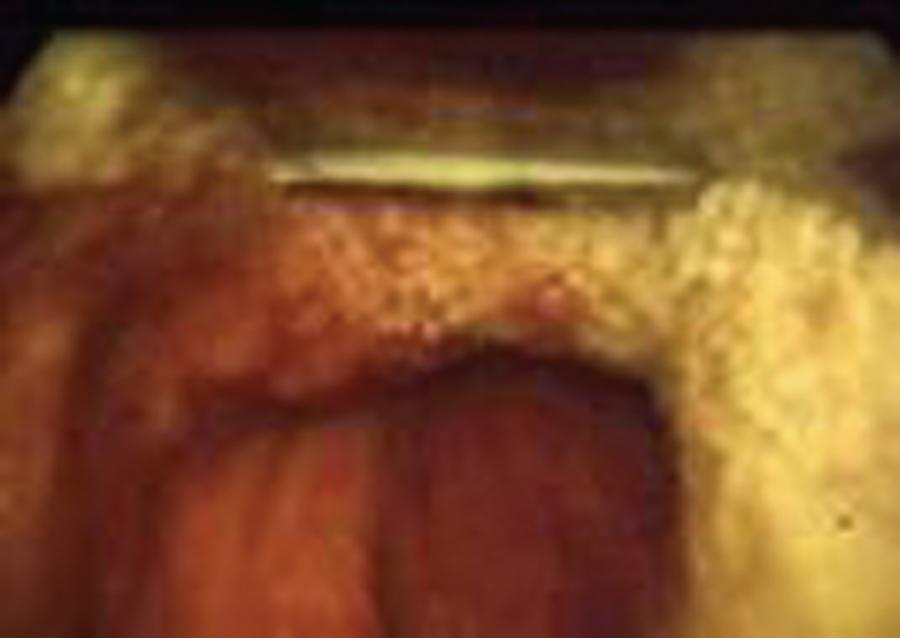
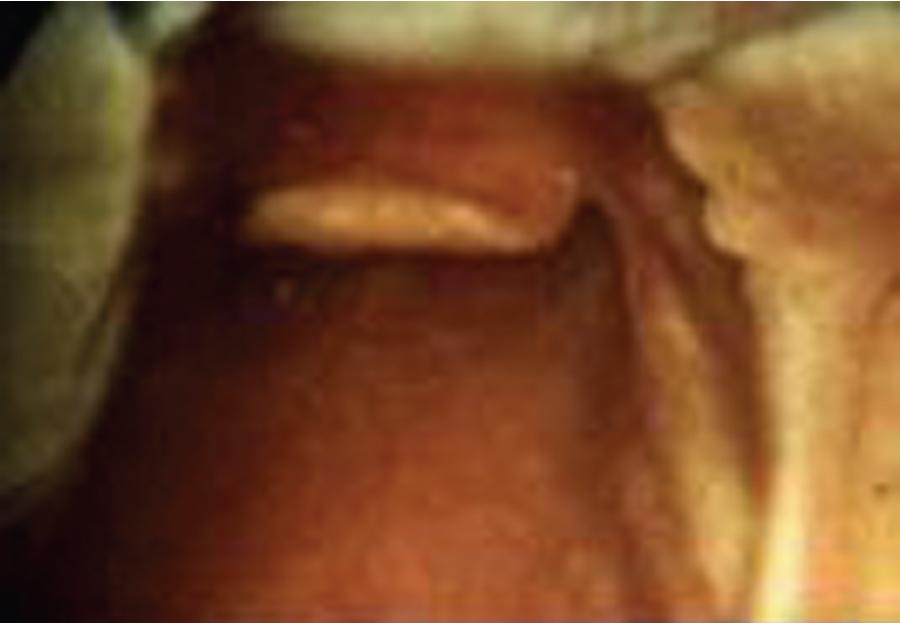
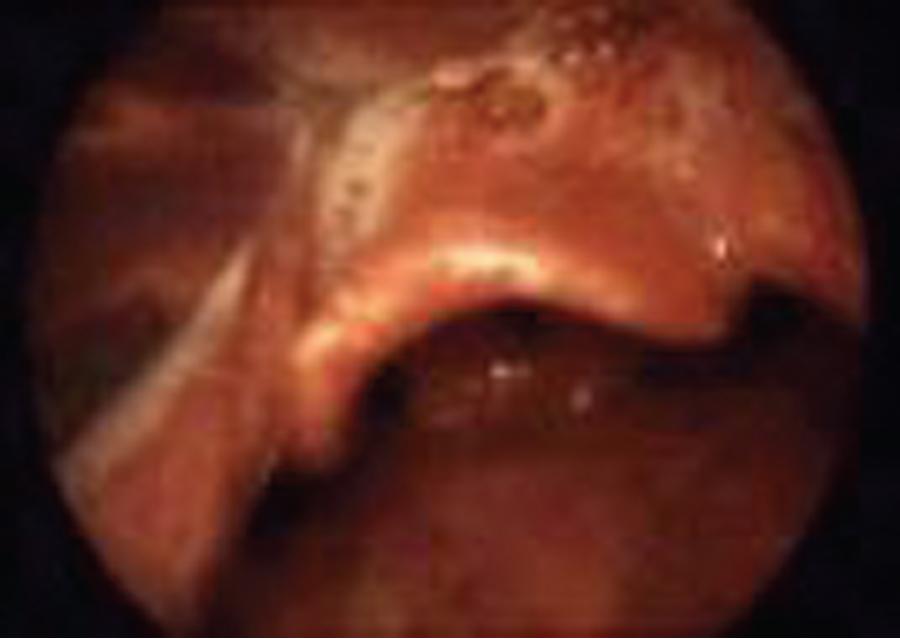

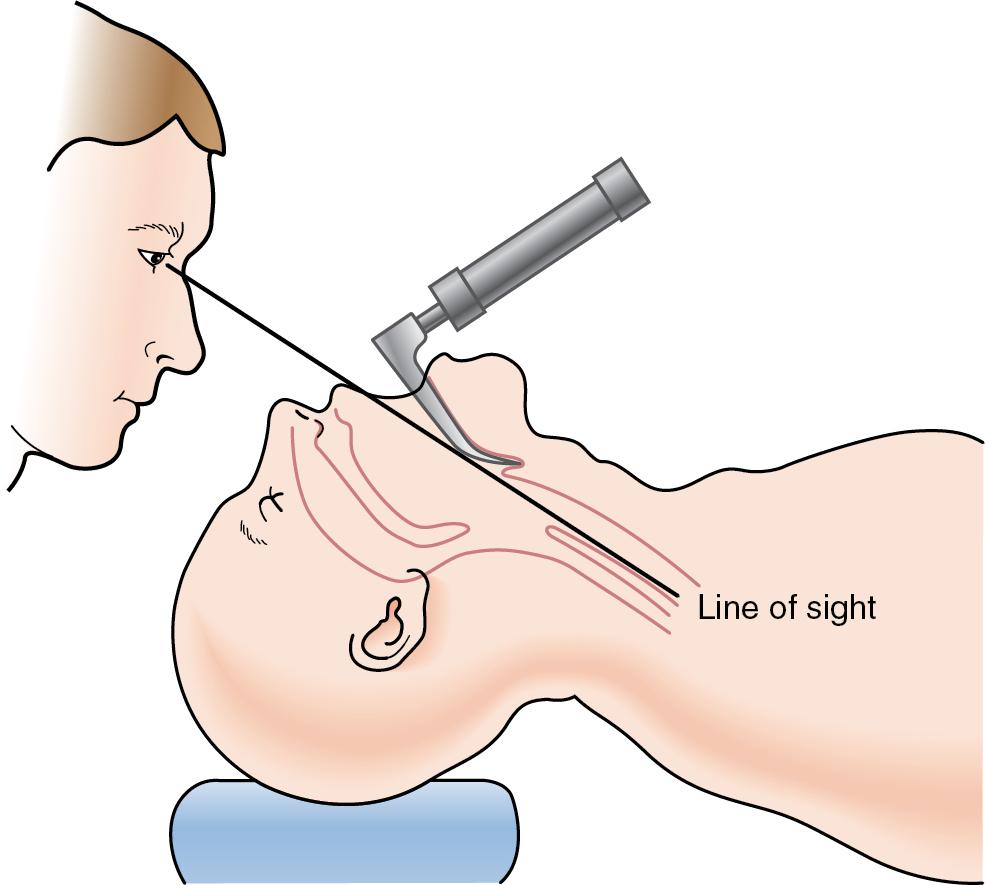
Combined use with a videolaryngoscope (VAL) to assist with ETT placement
Channeled VAL devices (Pentax AWS, AirTraq)
Unchanneled VAL devices (GlideScope, McGrath, Storz C-Mac)
Very difficult to manipulate the standard bougie “around the corner” of the models with blades of excessive angulation (GlideScope, McGrath). These VAL models promote the likelihood of ETT delivery at an angle such that the tip impinges on the anterior tracheal wall or on the cricoid ring, thus limiting its advancement. Typically, ETT rotation will allow advancement, but bougie placement via the ETT may allow a well-lubricated bougie tip to slip off the impingement and allow ETT passage. A bougie with a maneuverable tip (anterior ↔ posterior movement) would potentially improve ETT placement through the glottic opening.
Excellent adjunct with conventionally shaped “Video C-Mac” and other conventional angled VAL blades.
Useful if ETT is located just proximal to glottic opening and the bougie is passed through the existing ETT and then manipulated into the trachea.
Use of the bougie to determine the location of the ETT (esophagus vs. trachea).
Hang-up test (Cheney sign).
Bougie tip will hang up on carina or mainstem bronchus, as opposed to simply passing unimpeded into the esophagus. Typically, a depth of 28–32 cm (carina) or deeper (32–36 cm, second bronchi) will allow confirmation of the bougie within the airway vs. the esophagus.
Useful in cardiac arrest or clinical situations in which it is difficult to discern proper ETT placement (i.e., cardiac arrest with no detectable ETCO 2 or access to such devices).
Unfamiliar with its use
Recent tracheobronchial reconstruction
A tracheal tube introducer “bougie” is an inexpensive, disposable, easily transportable airway device that requires minimal setup time, no battery or electrical power, and is noted on all the major airway management algorithm lists of desired airway devices that should be immediately available.
A variety of manufacturers offer bougie models in 55- to 65-cm lengths, usually 14–15F in size.
Solid and hollow bougie models are offered by some manufacturers.
Distinct black markings along the length of the bougie assist the clinician with the depth of insertion.
Though the bougie is capable of assisting intubation in nearly all airway situations except when “no view” is possible, it is most commonly used as an adjunct with grade IIb, IIIa, and IIIb laryngeal views. Even when the laryngoscopy reveals a full view (grade I), the bougie may be useful when the mouth opening is small or narrow and/or the hypopharyngeal opening is narrow (OSA, obesity, swelling) and passing the ETT may actually obstruct the view of the glottic opening. In this case, the narrower, more colorful tracheal tube introducer can be passed into the trachea with little visual obstruction taking place. Conversely, the floppy epiglottis is a challenge that may be technically difficult with many different airway adjuncts. The bougie may either be used to elevate the floppy epiglottis or be maneuvered around by virtue of the Coude tip. Though useful, the success rate is often less than 50%, and other airway device alternatives may be needed (intubating laryngeal mask airway [ILMA], VAL, flexible fiber-optic bronchoscope [FFB] ( Fig. E1.7 ).
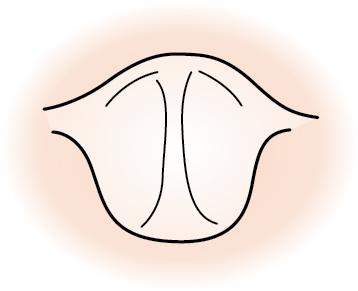
The bougie is grasped in the intubator’s right hand at the 20- to 25-cm mark.
It is passed alongside the laryngoscope with the 30-degree angled tip (Coude) anteriorly.
The tip is advanced anterior to the arytenoids and into the larynx (grade IIa, IIb).
The tip is then advanced underneath the epiglottis and past the vocal cords blindly (grade IIIa).
The tip lifts the floppy epiglottis and is then advanced blindly past the vocal cords (grade IIIb).
Advancement into the trachea to a depth of 22–26 cm in an average adult
Tip may “bounce” or “click” past the tracheal rings, suggesting tracheal placement.
This is a helpful sign but does not guarantee intratracheal placement.
Conversely, the lack of “clicks” does not guarantee the position of the bougie, nor does it rule out location within the trachea.
Ten to fifty percent of bougies passed into a grade III airway may enter the esophagus
Grade IIIa: 5%–12% may enter the esophagus
Grade IIIb: 30%–50% may enter the esophagus
Quickly deploy backup strategy (SGA, FFB, VAL)
Some may consider the bougie a poor choice in grade IIIb view
Tip may be gently advanced farther (28–36 cm) to contact carina/mainstem bronchus of second bronchi
Tip hang-up provides tactile feedback during blind passage
Detection of carina/bronchus is reassuring to operator
Advancement past 35–40 cm without hang-up strongly suggests the bougie is in the esophagus
Using hang-up or Cheney sign lowers the incidence and dangers of passing the ETT into the esophagus, bougie should be retracted to 23-25 cm depth, held securely then ETT may be advanced over the bougie
Eliminates the delay of verifying the ETT location by insufflation, capnography, auscultation
Decision time: passing the ETT
If time permits, generously lubricate the ETT
Smaller-sized ETTs pass over the bougie more easily than larger ones
Maintain tongue displacement with laryngoscopy/hand grasp
Pass the ETT, but do not force the advancement (an assistant should grasp the proximal end of the bougie to stabilize it)
Anticipate resistance at 16- to 17-cm depth because of impingement on arytenoid/vocal cord (two methods to remedy this) ( Fig. E1.8 ).
Preemptively advance ETT while rotating in the counterclockwise (CCW) direction to allow ETT bevel tip to avoid impingement on the glottic structure.
If resistance is encountered, stop and withdraw ETT 1–2 cm and then rotate CCW and advance the ETT into the airway.
If ETT fails to pass, the patient may be ventilated and oxygenated with bag-mask ventilation (move the bougie to the corner of the mouth).
Change to a smaller-diameter ETT (to ease advancement over the bougie) and assume the glottic opening may be swollen, impeding entry.
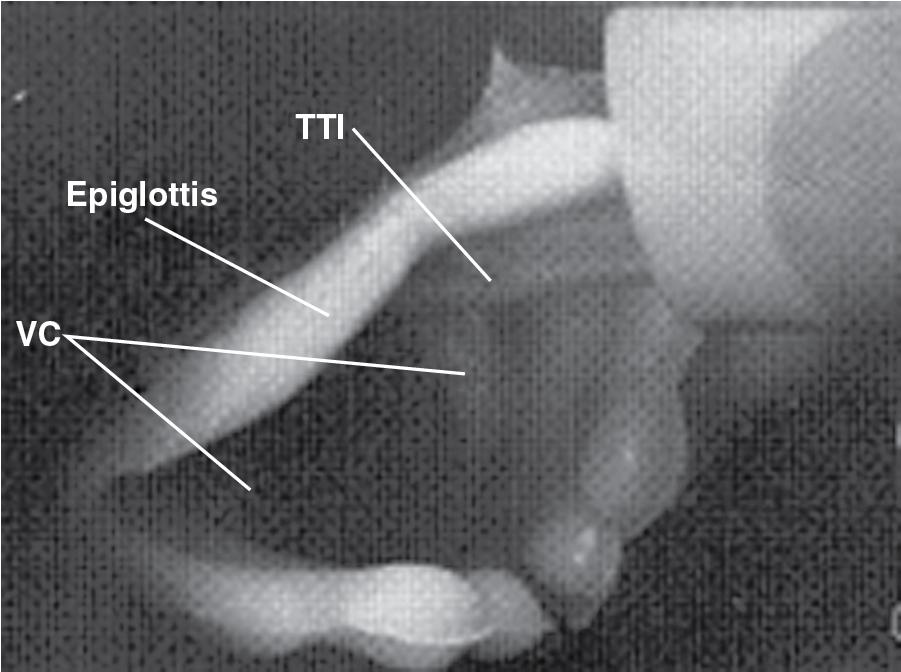
After advancement of ETT into the trachea, stabilize the ETT in position, and remove the bougie. Be sure to hold the ETT in place as the bogie is removed.
Standard methods of determining the ETT position are required.
Inability to pass the bougie underneath the epiglottic edge (grade IIIa) or inability to lift the down-folded or floppy epiglottis (grade IIIb).
Depending on the skill and experience of the operator and the condition of the patient, time spent advancing the bougie should be limited so as not to endanger the patient’s condition (SpO 2 ).
If unsuccessful, quickly move to another accessory device to secure the airway.
Infrequent complications:
Minor tissue injury, airway trauma
Esophageal placement of bougie
Esophageal intubation (the hang-up test should eliminate this hazard)
Serious, rare complications:
Mucosal laceration, bronchial/carina perforation if extreme force is applied to bougie advancement or the patient’s underlying airway anatomy is compromised/diseased
The simplicity of the trachea tube introducer makes it an attractive option for assisting with trachea intubation in the situation when a restricted laryngeal view is available with laryngoscopy. A variety of uses for the bougie make it a desirable addition to the difficult airway cart or bag, made accessible at the bedside in the ICU and other remote locations in the hospital. The bougie is a suggested option in the management algorithms offered by anesthesiology societies in the United States, Canada, the United Kingdom, Germany, and many other countries.
Emergency rescue of the airway when tracheal intubation is the goal
Failed conventional intubation attempts
Failed bougie-assisted intubation
Failed VAL intubation
May be a substitute for conventional SGA device after its failure to secure successful ventilation/oxygenation
Inexperienced operator/airway team
Major risk for regurgitation/aspiration (relative; loss or lack of airway is worse)
Oral cavity inaccessible/trismus
Similar to other SGA devices
Equipment for mask ventilation
Induction medications, topical anesthesia medications, and equipment for intubation
Disposable or reusable models of the ILMA, ETT, and stabilizing rod
Lubricating jelly
Syringe for cuff inflation/deflation
Tape to secure SGA
Bite block not needed
Manometer to measure cuff pressure (<60 cm H 2 O)
The ILMA is similar to other SGA devices that occupy the periglottic area and surround the glottic opening with a cuff. Passing the ILMA into the oral cavity is easier than the comparative standard LMA, because it is designed with an intrinsic curve easing passage into the hypopharynx. The inflatable cuff lies in the hypopharynx and essentially seals the supraglottic region from the epiglottis down to the cricopharyngeal (upper) sphincter. The rigid construction of the ILMA is limited by its diameter, so adequate mouth opening is a prerequisite. The sealed ILMA allows positive-pressure ventilation to be delivered. Occasionally, the ILMA will afford effective ventilation if the standard LMA model fails, and vice versa (as could other brands).
In general, placement of the ILMA can be performed in the exaggerated “sniff” position or the other extreme, a neutral cervical spine. In the presence of cervical spine immobility, it is best to maintain stabilization yet remove the front collar to improve oral access. After cuff deflation, the ILMA is lubricated and then passed along the roof of the mouth across the hard to soft palate, encouraging smooth advancement along the posterior throat so as to minimize getting hung up on the epiglottis or causing its down-folding. The distal tip of the ILMA typically comes to lie in the cricopharyngeal region. Unfortunately, the cuff end may buckle over on itself, come to lie over the glottic opening, or be displaced in a contorted position that impedes effective ventilation and oxygenation ( Figs. E1.9–E1.16 ) .
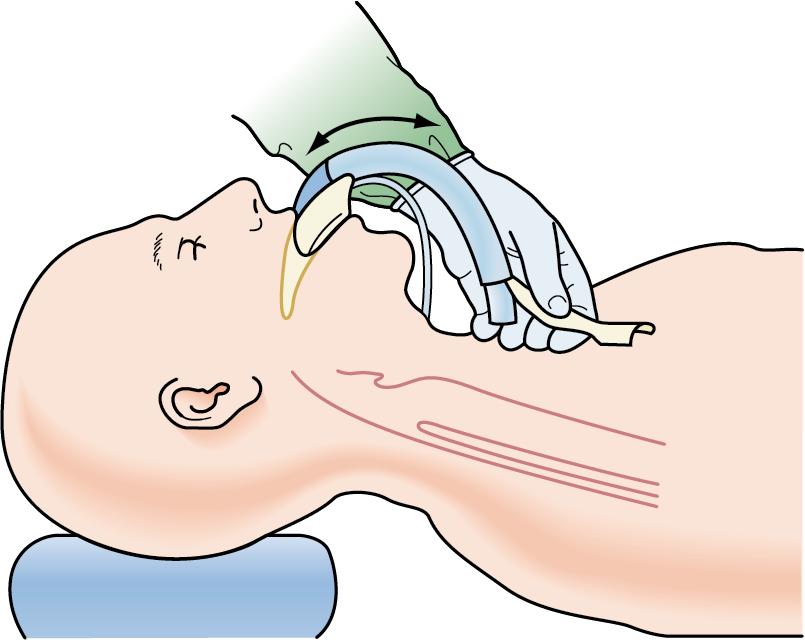
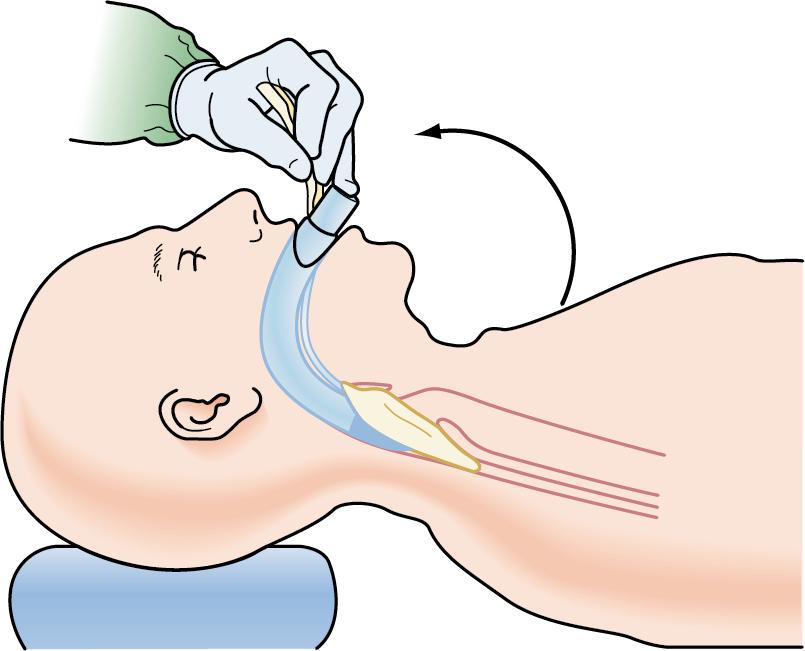
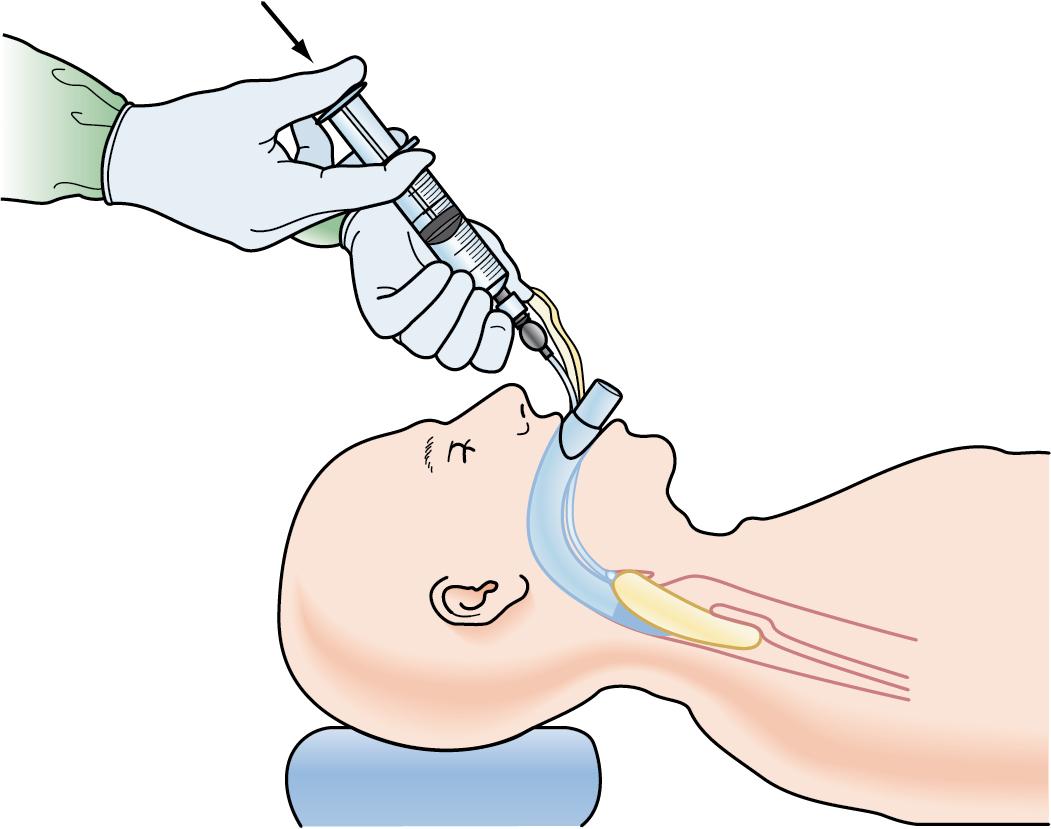
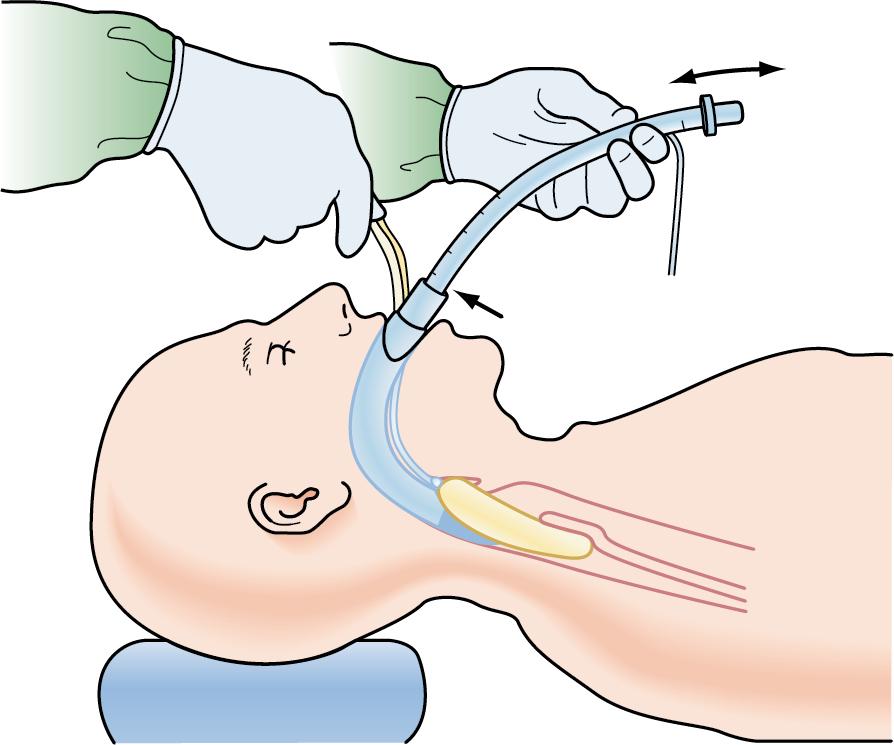
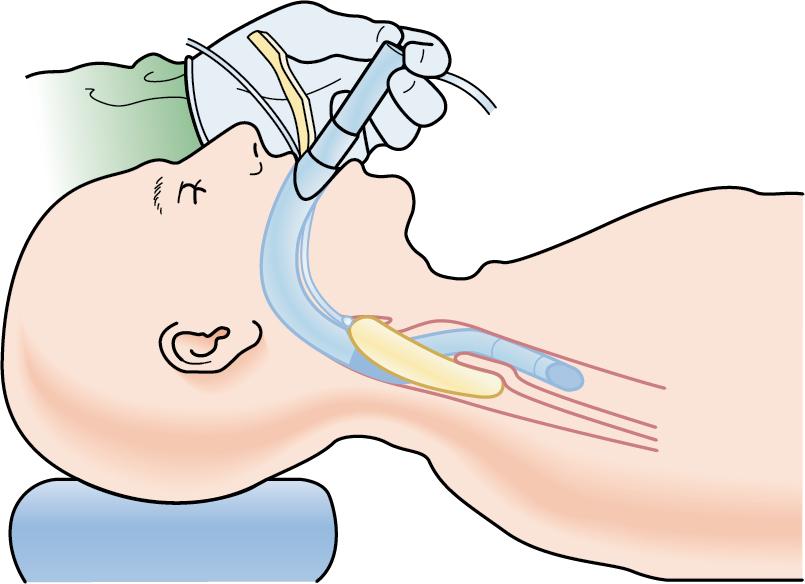
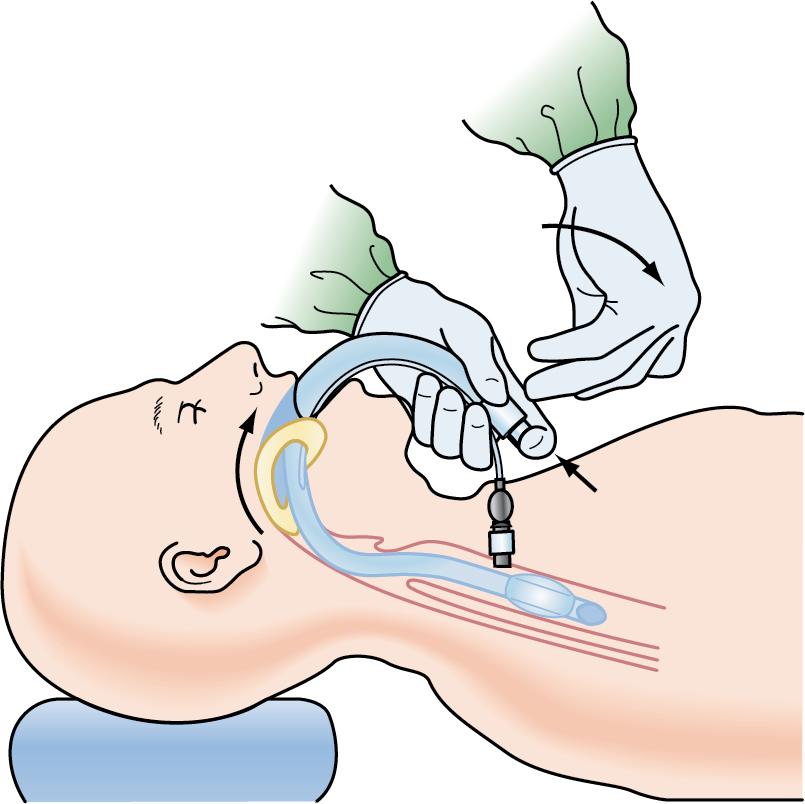
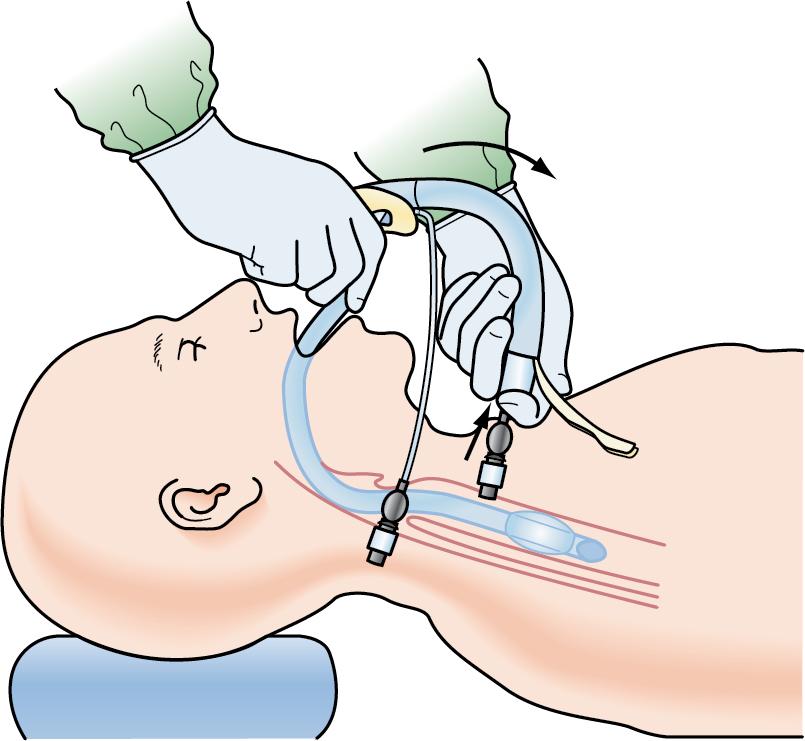
The ILMA is placed into the airway in a similar fashion as other SGA products. However, the shortened length of the ILMA model and its handle may be easier to place than the standard SGA model. Placement is augmented by passing it along the hard to soft palate posteriorly into the hypopharynx, posterior to the epiglottis. It too comes to lie with its tip atop the cricopharyngeal area posterior to the arytenoids/glottis. The tip may fold over or under and impede air exchange or be sensed by an incomplete cuff seal (leak). This can be remedied by performing the “in-and-out” or “up-and-down” maneuver (simply moving the ILMA slightly inward and outward to free up the distal tip). Cuff inflation is followed by positive-pressure oxygen delivery. Successful placement allows the chest to rise and ETCO 2 detection, with no audible air leak, to approximately 15–25 cm H 2 O pressure applied to the ILMA. Always confirm ventilation before attempting ETT advancement via the ILMA.
Two maneuvers are handy to improve success in ILMA placement and intubation:
After ILMA placement, the Chandy maneuver #1 involves using the ILMA handle to optimize the positioning of the ILMA within the airway, with the goal of maximizing tidal volume, ETCO 2 , and the feel of “bagging.” The ILMA is held in this position in preparation for passing a lubricated ETT. The included LMA brand wire-reinforced ETT is an excellent ETT for passing, but it is suboptimal for long-term use in the ICU airway (if duration of intubation is >24–48 hours, one should consider changing the ETT over an airway exchange catheter to the standard ICU ETT model).
Limiting SGA insertion attempts to two to three is suggested by several sources. Once effective ventilation/oxygenation is established, passing an ETT may be the next objective. With the ILMA in the best ventilating position (Chandy #1), the Chandy maneuver #2 involves using the ILMA handle to slightly elevate or “lift” the ILMA (handle toward forehead, ILMA distal tip anteriorly) to improve the success rate of passing the ETT into the trachea, based on the ILMA portal being tilted toward the glottic opening and away from the esophagus. This lift increases seal pressure and improves the alignment of the ILMA to the glottic opening and corrects any flexion the mask has undergone after its placement. Malposition or flexion of the mask while in the ventilating position may alter the pathway of the ETT as it exits the ILMA. Generous lubrication of the ETT to ease passage through the ILMA lumen is absolutely essential. Intubation of the trachea may be performed blindly or with fiber-optic assistance. The skill to successfully intubate the trachea is attained by practice coupled with instruction by an experienced individual. Practicing the technique before an emergency situation arises is in the best interest of patient care.
Troubleshooting in the event of failure to intubate (typically caused by a down-folded epiglottis, ETT impaction on the periglottic tissues, too large or too small ILMA, or patient is resisting intubation because of inadequate sedation/analgesia/muscle relaxation/anesthesia).
If resistance is felt approximately 2 cm beyond the black transverse line marked on the ILMA ETT (or 15–16 cm marking on a standard ETT), the down-folded epiglottis may be blocking ETT advancement, as may the vestibular wall. Rotation of the ETT may allow passage if impeded by the vestibular wall. A down-folded epiglottis may need to be addressed by performing the “up-and-down” maneuver. This is a partial withdrawal of the inflated ILMA to a maximum of 6 cm, followed by reinsertion. This often frees the epiglottis from its down-folded position. Otherwise, FFB assistance is needed, or a different size ILMA may be tried.
If the ETT meets immediate resistance at 15–16 cm (black mark) or at a 4- to 5-cm depth past the black mark, then the ILMA is too large, and downsizing may help.
If resistance is encountered at 3 cm past the black mark, the ILMA may be too small. If an alternative-size ILMA is not available, external manipulation of the larynx either downward or caudally may assist with passing the ETT. Likewise, ETT rotation may be helpful.
The ILMA has an “epiglottis elevator bar” to assist in lifting the epiglottis up to afford improved ETT passage into the laryngeal inlet. When using bronchoscopic-guided ETT advancement, using the ETT tip to elevate the bar is best because the bronchoscope typically is not rigid enough to do so by itself.
Another miscellaneous yet quite important clinical situation that may prohibit intubation is excessive periglottic/glottic edema when viewing with the FFB. Massive airway edema may preclude advancement of the FFB-ETT owing to the inability to clearly identify the glottic opening; caution must be exercised to not advance the FFB tip into unrecognizable tissue planes. Excessive force on the FFB or ETT may lead to tissue injury and thus threaten the current airway patency by inducing further bleeding, edema, or swelling. Attaching a bronchoscopic swivel adapter to the ILMA itself or via the ETT may allow active application of positive pressure to the airway and promote lateralization of the edematous glottic tissues. This is analogous to the use of CPAP in OSA patients. The bronchoscopic adapter is too narrow to allow an ETT to pass through it. To remedy this, an Aintree catheter (bougie-type catheter with a lumen that allows a proper-sized FFB to be placed within the catheter) is sized to fit through the adapter and its diaphragm. The Aintree-FFB assembly may be passed through the bronchoscopic adapter, down the ILMA, and used to visualize the glottic opening. Once advanced into the trachea, the Aintree remains within the trachea as the FFB is withdrawn. The ILMA is then removed over the Aintree, and the ETT is advanced over the Aintree catheter in similar fashion to a bougie, tube exchanger, or FFB.
Blind intubation via the ILMA is useful and generally successful (90% within three attempts in the Hartford Hospital database for emergency intubations). Recent guidelines have leaned toward deploying bronchoscopic guidance for intubation so as to avoid blind insertion in the difficult airway situation. Moreover, recent societal recommendations have moved away from the ILMA toward the second-generation SGA models, despite an impressive track record of success with the classic SGA model (LMA) and the ILMA model design.
After “blind” intubation of the trachea, standard methods to confirm ETT position are pursued (chest auscultation, ETCO 2 detection, ETT misting, chest rise, etc.).
After fiber-optic–assisted intubation, the same clinical confirmation of ETT position should be pursued, even though visualization of the ETT within the trachea with FFB is considered failsafe. The caveat here is that FFB confirmation, though failsafe under ideal conditions, may be limited by secretions, edema, soilage, operator inexperience, faulty battery power, and other limitations seen in the ICU airway.
With the ETT-ILMA assembly in place, the ILMA has to be carefully removed from the patient while leaving the ETT within the trachea. Accidental tracheal extubation during ILMA removal could be disastrous.
Step-by-step removal of the ILMA is outlined later.
If one is unfamiliar with ILMA removal, a more experienced team should be summoned to assist with this task. Conversely, if the patient’s clinical condition needs to be stabilized before its removal, at a minimum, the air should be removed from the ILMA cuff (leaving the ETT cuff inflated) to reduce the pressure effect on the pharyngeal mucosa.
Common
As outlined under SGA
Inability to establish ventilation/oxygenation
Inability to intubate the trachea
Esophageal intubation
Obstructed advancement of the ETT through the ILMA
Infrequent
Dental damage, mucosal injury
Serious, rare complications
Regurgitation/aspiration (very rare)
The use of the ILMA has revolutionized airway management, especially in the emergency setting. It is an accepted component in the ASA airway management algorithm, in addition to all other algorithms offered by medical societies throughout the world. The presence of VAL has potentially altered the ILMA’s role as a logical and rational first step toward airway rescue when conventional methods fail or are inappropriate. However, the clinician must be familiar with this device and have it readily available as a backup for VAL difficulties or failures.
In the elective setting, the ILMA has an excellent track record for a high level of successful ventilation coupled with blind and FFB-assisted intubation. Its successful deployment in the acute care setting in the ICU, emergency department, or other remote locations outside of the operating room has been well received, though the success rate for both ventilation and intubation is tempered to a more realistic success rate of nearly 8–9 out of 10 patient encounters (Hartford Hospital database, TCM). Thus a backup plan must be in place to deal with ILMA failure and establish effective ventilation/oxygenation, and ultimately tracheal intubation, either blindly or with FFB assistance.
Secure the airway in the elective setting with the patient awake, with adequate local anesthesia topicalization or nerve blocks
Trismus, severe temporomandibular joint (TMJ) disease, limited cervical range of motion
Known difficult mask ventilation, intubation
Secure the airway emergently in the setting that mask ventilation/oxygenation is effective
Retrograde wire-guided intubation, in the best situation, may require 2–5 minutes to complete; hence one must be able to maintain successful ventilation/oxygenation.
Considered an effective airway rescue in the nonemergent pathway on the ASA difficult airway algorithm ( cannot intubate, can ventilate) when oral or nasal intubation is impossible or failed for a variety of conditions
Any reason the patient is a “difficult airway”
Massive oral, nasal, or pharyngeal hemorrhage (must be able to locate wire)
Trismus (must open at least one fingerbreadth)
TMJ abnormalities limiting mouth opening (must open at least one fingerbreadth)
Structural deformities of oropharynx, congenital or acquired
Mass (cancer, tumor, polyp, or other if not directly in line of wire advancement)
Traumatic injuries making oral/nasal tracheal intubation difficult or impossible
Maxillofacial injuries
Cervical spine instability
Secure the airway electively when difficult airway factors are known or suspected to exist and intubation by other means may be difficult or impossible.
Absolute contraindications
Transection of trachea with retraction of distal end into the mediastinum
Fracture or other significant injury of the larynx or cricoid cartilage
Infection, cancer, mass at site of wire insertion (cricothyroid membrane) or in pathway of wire advancement
Unfamiliarity with the procedure
Relative contraindications *
* Relative contraindications may be overlooked in the emergency situation.
Infants and toddlers (<3 years)
Bleeding diathesis
Patients with massive neck edema, lack of landmarks
Guidewire (suggested >60 cm) matched to appropriate needle size allowing advancement
20-, 18-, 16-, or 14-gauge cutting needle on a syringe
Cuffed 6.0 endotracheal tube
Hemostat or Kelly clamp
Alternative: manufactured retrograde wire intubation kit (Cook Critical Care) (see Fig. E1.16 )
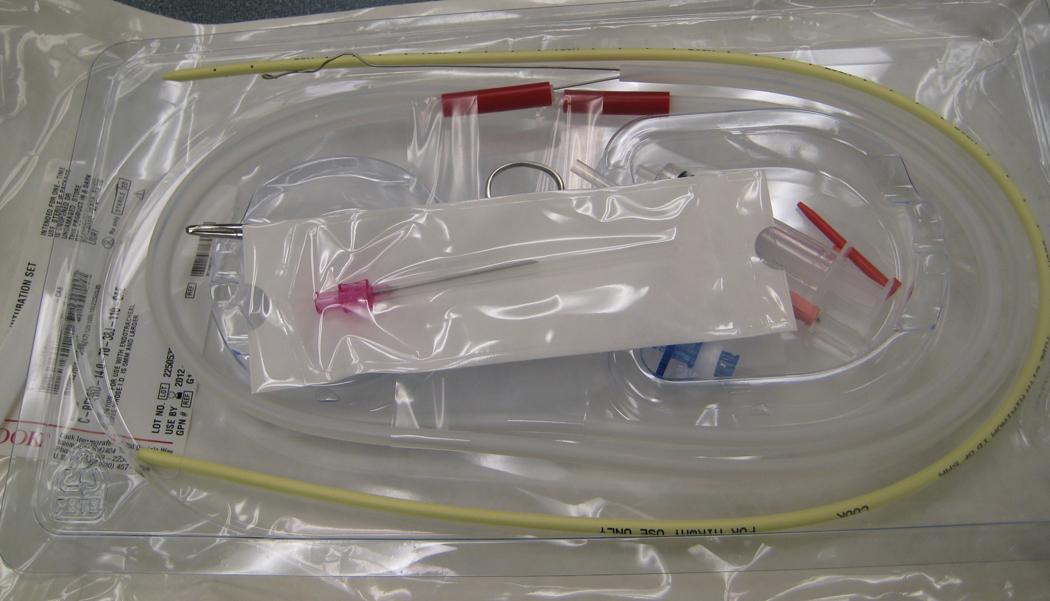
Optional: FFB
The cricothyroid membrane is located between the superior thyroid cartilage and the inferior cricoid ring. The cricothyroid membrane is located just 1.5–2 cm below the vocal cords, so care must be practiced when advancing a needle caudad, as the underside of the vocal cords could be impaled. Passing the ETT over the wire or obturator/wire may be met with resistance at the 16- to 17-cm depth, as the ETT tip may impinge on the vocal cords or arytenoids. This is the inherent danger of passing the ETT blindly over the wire or obturator/wire assembly. The location of the distal tip (having met resistance) may or may not be at the position below the vocal cords. This is the challenge of the retrograde wire method; knowing the location of the ETT tip is unknown when the decision is made to remove the wire. If the ETT tip is erroneously positioned above the glottis, then the access to the airway is denied with wire removal; hence, the advantage of using the FFB as an intubation guide ( Fig. E1.17 ).
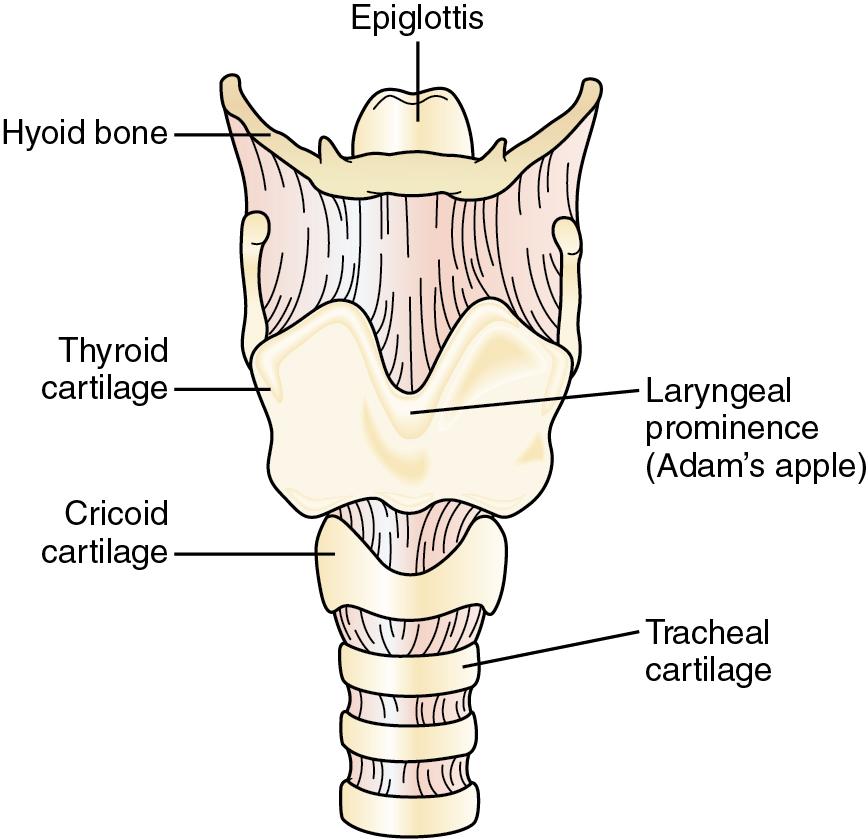
Retrograde tracheal intubation
Needle insertion directed cephalad; operator should approach with dominant hand more caudad (e.g., right-handed operator on right side of patient)
Puncture cricothyroid membrane with needle directed cephalad ( Fig. E1.18 ). Aspirate air with syringe to locate air column (1–2 mL of saline in syringe; allow bubbles to percolate to verify the air column).
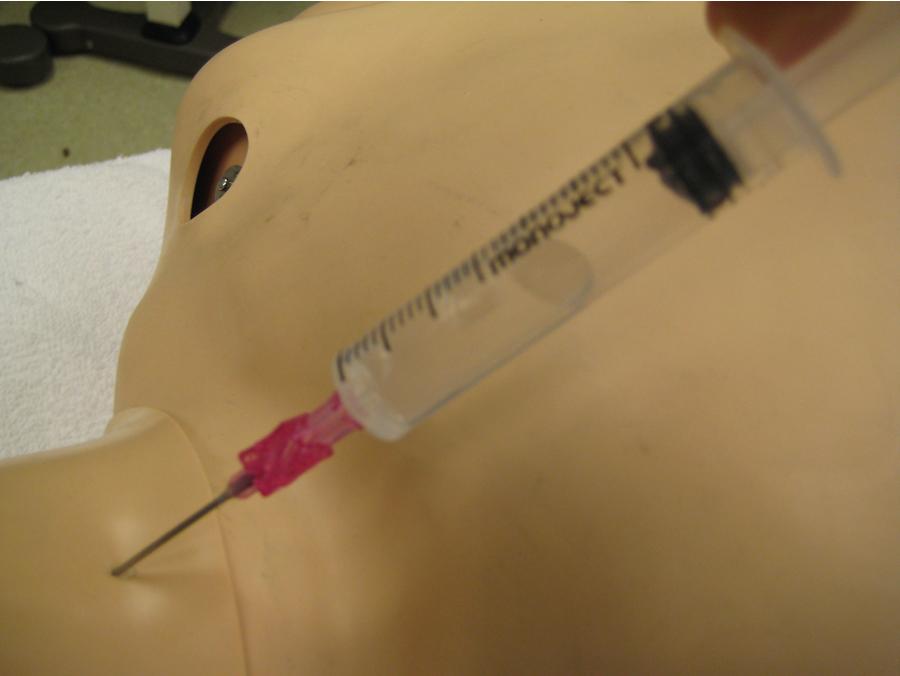
Pass the guidewire through the needle aimed superiorly so that the distal end of the wire may be retrieved from the mouth (or if desired, nose) of the patient. Withdraw needle off wire.
Pull majority of wire out of the mouth (or naris)
Secure distal end of wire by clamping hemostat at the level of the cricothyroid membrane ( Figs. E1.19 and E1.20 ).
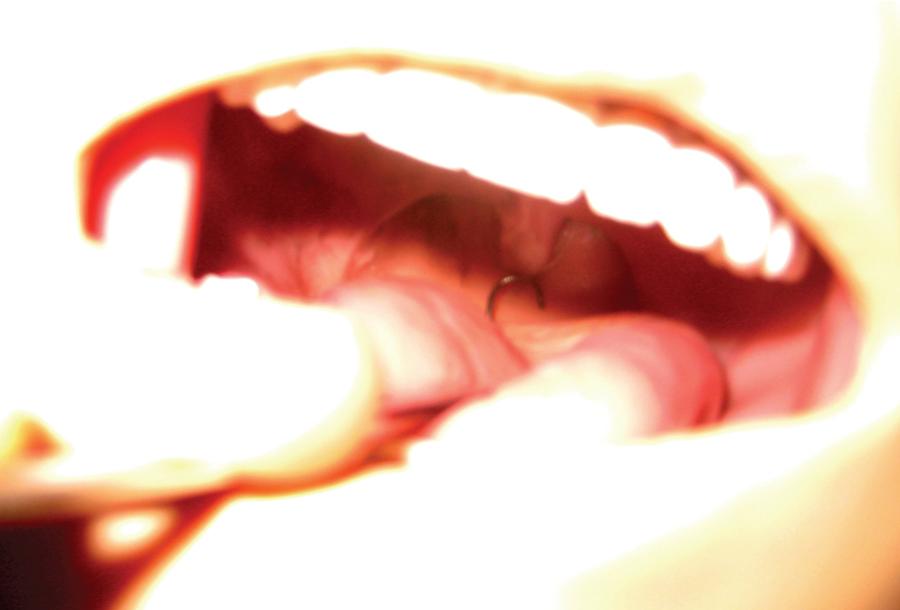
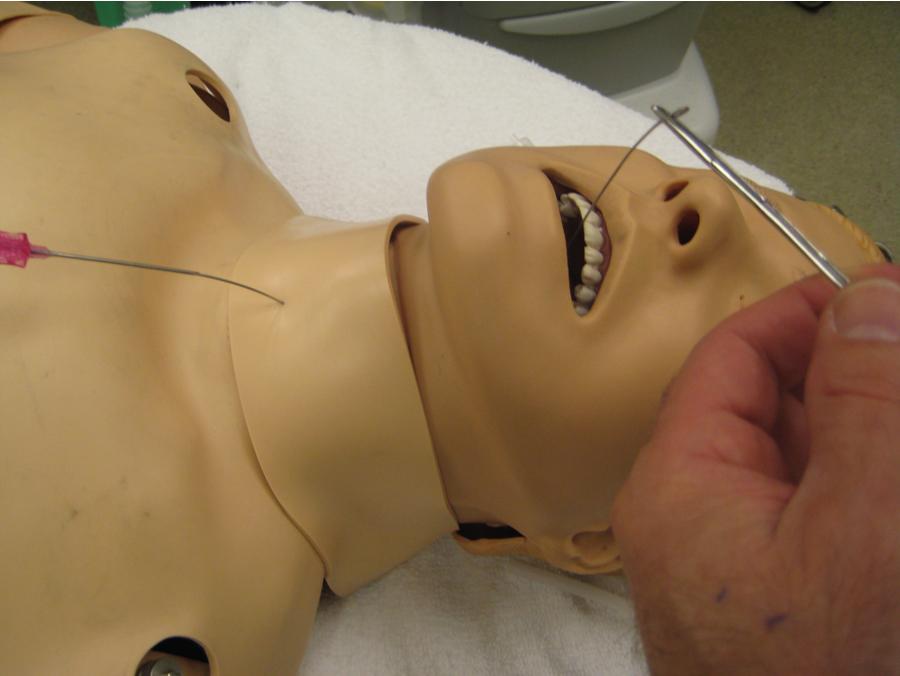
Three choices to pass ETT down the wire into the airway (nasal or oral): (1) wire assisted, (2) wire with obturator to reinforce wire, (3) flexible bronchoscope (loaded with ETT) passed over wire into airway
Wire assisted
Load lubricated ETT over oral (or nasal) end of wire, passing wire into tube through the Murphy eye.
Pull wire relatively taut and straight.
Advance ETT over wire into trachea to cricoid area and then, gradually relaxing cricothyroid end of wire, advance ETT to appropriate intratracheal location.
Release cricothyroid end of wire, and withdraw wire out of ETT.
Confirm ETT position (auscultation/capnography).
Wire with obturator to reinforce wire ( Fig. E1.21 )
Pass obturator over wire into airway until resistance is felt.
See manufacturer’s instructions for Cook retrograde intubation kit.
Load lubricated ETT over oral (or nasal) end of wire/obturator.
Advance ETT into trachea to cricoid area.
Remove wire from cricothyroid membrane end, and then advance obturator distally into trachea.
Advance ETT to appropriate intratracheal location.
Confirm ETT position (auscultation/capnography).

FFB (loaded with smaller-sized ETT [6–7 mm]) ( Fig. E1.22 )
Advance wire through the suction portal of the FFB.
Grasp wire end from top of FFB.
Advance FFB down wire, observing the airway structures as you advance ( Fig. E1.23 ).
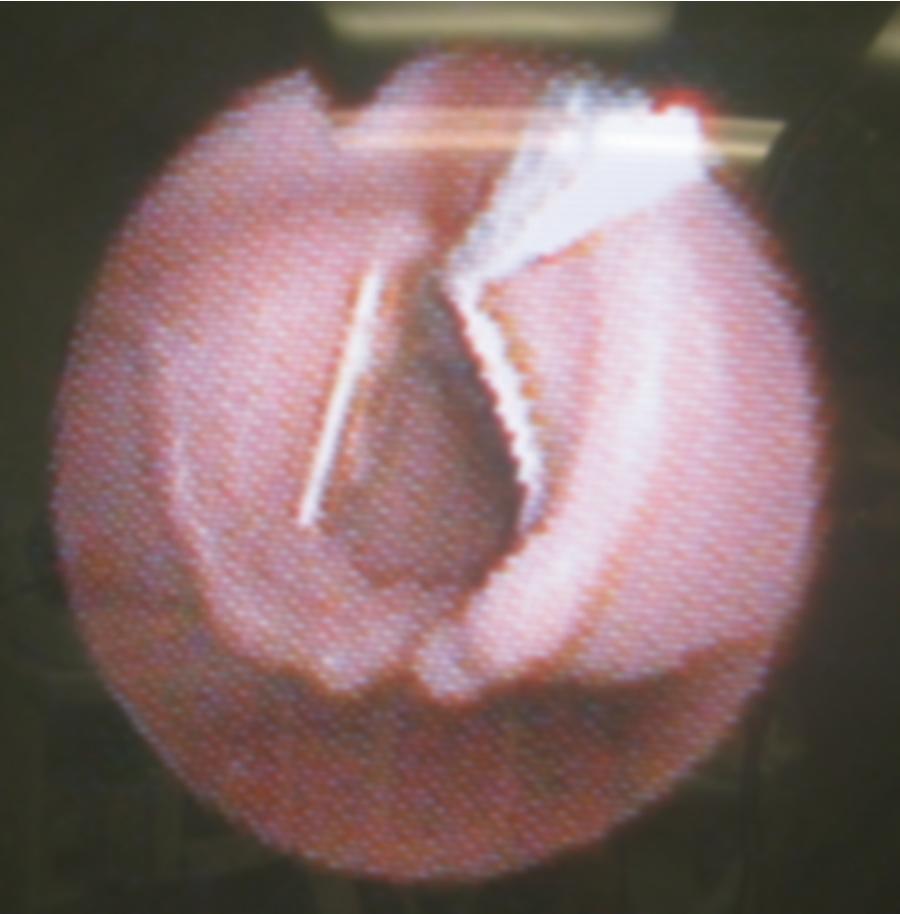
Advancing the FFB to distal end of wire will occlude view and appear “pink” (backside of cricothyroid membrane). Correct position may be verified by darkening the room to transilluminate the cricothyroid membrane puncture site ( Fig. E1.24 ).
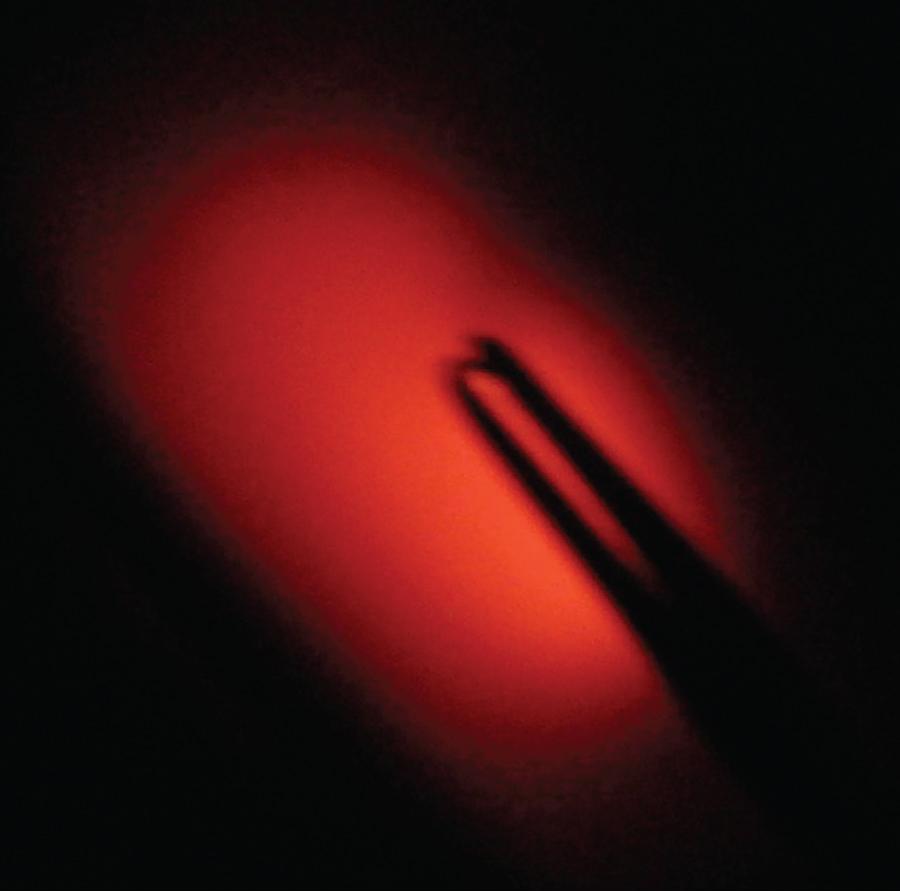
Once the FFB is below the vocal cords, the cricothyroid end of wire may be released as the fiberscope is advanced to the carina and wire and then pulled out of the fiberscope.
Or the wire may be pulled out inferiorly through the cricothyroid puncture and fiberscope and advanced into the trachea.
Advance the FFB tip into distal trachea, and advance the ETT into position and confirm.
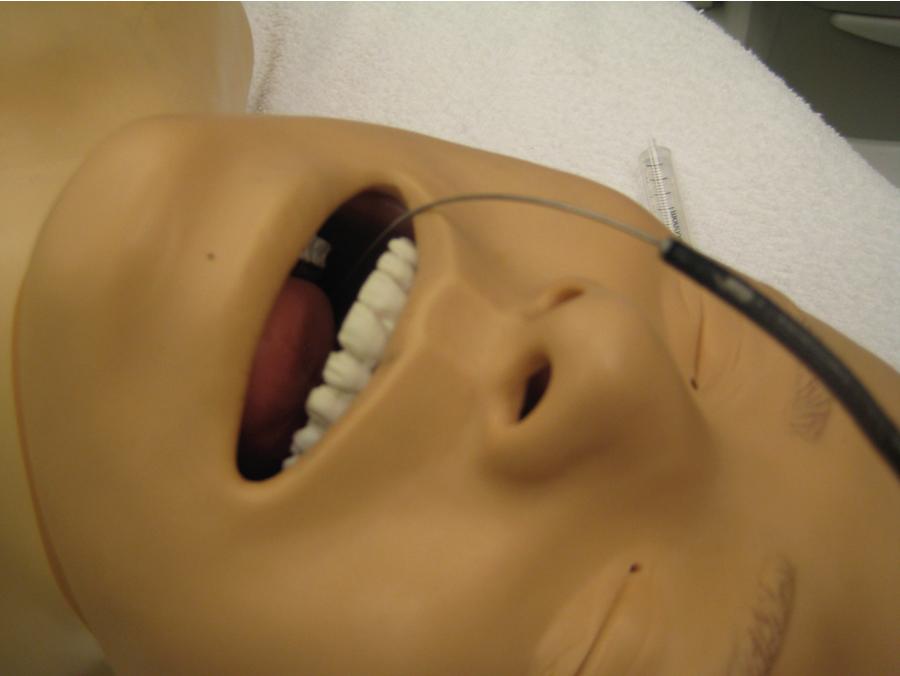
After advancement of ETT into the trachea, stabilize the ETT in position.
Standard methods of determining the ETT position are required.
Become a Clinical Tree membership for Full access and enjoy Unlimited articles
If you are a member. Log in here